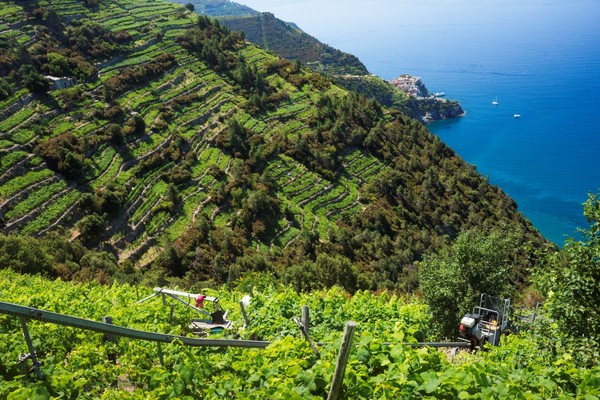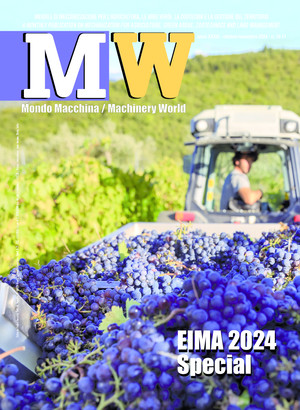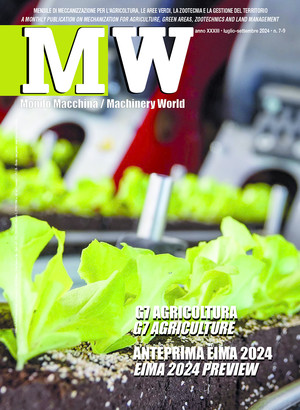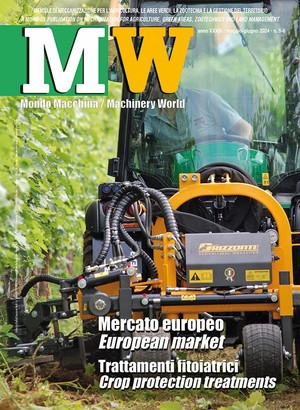
Mechanization for 'heroic' agriculture
Under very difficult environmental conditions, agricultural production is normally managed with a massive reliance on manual labour. Nevertheless, good mechanisation solutions are available, benefiting the profitability of high value-added crops
Beyond more or less courtly definitions, so-called 'heroic agriculture' is identified in those agricultural productions practised on land that has certain characteristics, namely: a slope of more than 30%; altitude above 500 m above sea level; cultivation on steps or terraces. It is immediately obvious that in such extreme conditions, especially due to the slope of the terrain, and partly also due to the presence of steps and terraces, mechanisation can only be developed in a very partial way, with solutions that basically only facilitate manual work, which remains absolutely central. That is why heroic agriculture is inseparably associated with the heroic farmer, i.e. the one who, with passion, stubbornness and attachment to the land, carries out a strenuous activity that is not without risk, in many respects. This activity also entails other added values, such as the preservation of the land: think for example of the maintenance of dry stone walls, well-kept pedestrian paths, and adequately controlled contour vegetation. In a word, it is about preserving the landscape in its naturalness. But there is also another very important factor, which concerns the practice of niche, site-specific, ancient crops: this is an invaluable heritage in terms of biodiversity.
Considering the spread of wine production in Italy, it is almost automatic that heroic agriculture is almost inseparably associated with 'heroic viticulture', with which, however, it should not be confused, since several other agricultural products, such as medicinal herbs, red fruits, certain leguminous plants (e.g. lentils), ancient fruits, etc. are successfully cultivated in this context. In any case, there is no doubt that (small) mechanisation, which has been developed to best serve commonly performed cultivation practices, makes substantial reference to viticulture. What follows is a quick (and admittedly incomplete) overview of what the market offers in this regard.
Transporting the harvest and cultivation equipment is certainly the biggest challenge faced by 'heroic farmers', as the road network is either completely absent or unsuitable for the transit of machinery, both due to its small size and, often, the precarious condition of the ground.
Rack monorail. The single-track monorail is a solution for the mechanical transport of goods or persons; its adoption is particularly suitable for steeply sloping terrain, where the construction of a driveway is not possible (and/or not appropriate, also for environmental reasons). Well-known at international level are the monorails serving the vineyards of the Cinque Terre, a Unesco heritage site, and more generally those that make it possible to cultivate vines in other celebrated areas: the Valtellina in Lombardy, the Valle D'Aosta, the Prosecco hills between Conegliano and Valdobbiadene (province of Treviso), on the Island of Elba in Tuscany, in the Sila and Pollino areas in Calabria and Pantelleria in Sicily, etc. Monrail of Grugliasco (province of Turin) stands out for its offer of systems of this type, which not only make use of classic petrol engines, but also propose innovative battery-powered electric vehicles, which bring advantages such as reduced gaseous pollutant emissions and noise impact, simplified manoeuvrability, the possibility of remote control, and reduced energy consumption, thanks also to the possibility of energy regeneration during downhill travel. More specifically, the petrol versions can be fitted with engines up to 7 Hp, to transport up to 750 kg on a 35° slope (70%); they are equipped with speed limiting brake, parking and emergency brake, and reverse shuttle. Conversely, an electrically-propelled range is also offered: the Electric 2000 model is fitted with a 4.5 kW brushless motor powered by a 90 Ah 48 V lithium-ion battery (replaceable with a larger 180 Ah battery), with which it can transport a load of 400 kg at a maximum speed of 2.7 km/h on an even 83% gradient (corresponding to a 40° angle), or an impressive 1,850 kg at a slower speed but on a still considerable gradient (37%, i.e. 20°). With the larger capacity battery pack, the claimed autonomy is more than good - from 2.5 to 6.5 hours - obviously depending on the intensity of use.
Motor wheelbarrow. It is definitely the most suitable vehicle for carrying out various operations where it is necessary to distribute products, such as fertilisers and plant protection products, or to harvest locally. As driving elements, rubber tracks lend themselves well to the purpose, especially because of the large contact area that ensures optimum grip on inconsistent surfaces, while at the same time producing limited compaction, but they also offer the possibility of steering in really tight spaces, such as the headlands of terraces. With reference to the Italian market, there are several manufacturers who have models in their catalogue suitable for the vineyard, even complete with the operating part. Camisa of Compiano (province of Parma) offers a wide range of models, also in small sizes, suitable for narrow terraced rows. For example, the TP280 Eco model with an accompanying operator, equipped with an endothermic internal combustion engine of about 5 Hp, has a mass of 160 kg empty, a load capacity of about 300 kg on a platform 900 mm long by 650 mm wide (with sides that can be widened if necessary), and a maximum speed of 4 km/h, which can be managed through two forward gears and a reverse gear. Where a little more inter-row space is available (and where there is even a minimum of viable road space), Camisa again offers the TP 500 S model specifically for viticulture, equipped with an endothermic internal combustion engine of around 20 Hp. It is a professional model, equipped with an on-board driver's seat, and optionally with a 540 rpm power take-off, a hydraulic lift and one or more hydraulic take-offs of up to 25 l/min capacity, but above all with a sprayer module for phytosanitary treatments. The unladen mass is approximately 400 kg, the load capacity up to 500 kg and the maximum speed 5 km/h.
In viticulture, phytosanitary treatments have always been the most labour-intensive operation. So, even where environmental conditions are difficult, mechanisation proves to be important. On the basis of the wheelbarrow, various manufacturers offer exclusive set-ups: Waibl Diethart of Merano-Sinigo (province of Bolzano) produces a sprayer with mechanical atomisation on a tracked, self-propelled, operator-mounted base. Equipped with a 130 l fibreglass mix tank, it is driven by a 16 Hp internal combustion engine, which also drives a 55 l/min piston and diaphragm pump and a 20,000 m³/h fan. To best adapt to different types of vine cultivation, the machine can alternatively be equipped with the classic series of nozzles arranged in a crown around the axial fan, or with a turret (also in a low version) in stainless steel with adjustable fins and tangential fan, suitable for the pergola.
Row management. From pruning... Undoubtedly, the use of the modern electronic pruning shears has brilliantly solved all operational problems even in particularly difficult conditions, including that of the necessary battery pack autonomy, which can now also be carried in a convenient backpack, ensuring a whole long day of uninterrupted operation. Rather, pruning shears have always entailed a safety problem, relating to unintentional, as well as dangerous, interference of the moving blade with the operator's finger or hand not engaged in gripping the tool.
There are already several models on the market that operate in 'man-present' mode, i.e. the blade moves towards the striker only as long as the trigger is held in, immediately reversing the movement (i.e. opening) upon release, even if it has not completed its normal stroke. Now, however, Pellenc has introduced the C3X model with the 'Activ'Security' function, which immediately stops the blade in the event of contact with the user's finger, by means of a natural conductive circuit created by 3 points of contact. In detail, thanks to a double hand contact on the trigger and lower body, 'Activ'Security' is activated as soon as the user touches a metal element of the cutting head with the other hand. For optimal safety in high humidity, the use of conductive gloves is recommended.
... to inter-row work. In this case, the motor cultivator seems to be the most versatile vehicle. In the very wide range of models available, the most suitable for heroic viticulture are those of low power (approximately 5-8 Hp), with limited size and weight, suitable for coupling with equipment of reduced working width. For example, the PowerSafe 328 model from Ferrari in Luzzara (province of Reggio Emilia), which is part of the BCS group, can be ordered with four different engines, three petrol engines from around 5 to 8 Hp, and one diesel, 7.5 Hp. It has 3 forward and reverse gears for a maximum speed of 4 km/h and power take-off at around 1000 rpm, all contained in just 76 kg, with a less powerful engine and tyres of size 4.00-8, making it easy to transport to inaccessible sites and very manoeuvrable in tight spaces. The equipment that distinguishes the range to which it belongs, however, is the hydraulically actuated PowerSafe multi-plate clutch in an oil bath, which provides advantages both in terms of safety, as it has a built-in brake that immediately stops the machine and the implement if the handlebar is accidentally released, and in terms of ergonomics, as the lever actuation requires limited force, as it has to act on a hydraulic actuator and not on a spring via a cable, as is the case with traditional clutches. If the inter-row is to be worked periodically, then the implement to be coupled to the motor cultivator is the classic one, i.e. a hoe (commonly referred to as a 'tiller'), which for the model mentioned has a working width of approximately 50 cm. Conversely, if the row is to be kept grassed, an 80 cm reciprocating straight cutter bar should be coupled; instead, a 60 cm cutter bar is available for shredding pruning residues.
Dry stone walls
Recognised by Unesco as a world heritage site, dry stone walls form the structural basis of terraced cultivation, first and foremost the vine. In addition to being a fundamental element of the landscape, they must ensure appropriate and lasting stability of slopes, counteracting landslides and surface erosion. It is therefore quite clear that, in addition to their construction (or reconstruction), diligent and careful periodic maintenance is essential, which among other things can ensure proper drainage of water, especially rainwater.
Not only structural and landscape functions: dry stone walls are an important part of the ecosystem, a rich ecological niche. In fact, the interstices become home and hiding places for a microfauna rich in insects, small reptiles and amphibians that collaborate in maintaining a healthy, pest-free environment. Moreover, the microclimate created inside (due to the condensation of dew in the cracks) favours the development of Mediterranean plants, which, thanks to the greater availability of water, can cope with and overcome the summer drought. This is helped by the combined action of mosses and lichens, the basis for the life of other higher plants.
The construction technique is relatively simple: it starts with the foot, usually two parallel rows of large stones, often placed just below the walking surface, and then partially covered with earth. Successive layers of stones rest on the foot, without any added binders. The empty spaces are progressively filled with finer material. Once the desired height has been reached, the wall is closed with the cap, consisting of squarer stones, to form a homogeneous level.
The sizing and positioning of the base of the drystone wall is logically the key element of its stability, and thus its durability. Local conditions, first and foremost the slope's gradient and its intrinsic stability, can greatly vary the optimal choice, but as a general rule, a foundation thickness of approximately 50 cm is considered for 1.5 m high walls, 70 cm for heights between 2 and 3 m, and 80-100 cm if they exceed 3 m.
Numerous research projects have also been developed on this theme: the recently concluded project InTERRACED - NET (Integrated Strategies and Networks for the Conservation and Enhancement of the Cross-border Terraced Landscape 2019-2022), financed within the framework of the Interreg V-A Italy-Switzerland 2014-2020 programme and based on the activities of 9 partners (7 Italian and 2 Swiss), proposed a functional recovery strategy, integrated between protection governance, enhancement of an intangible heritage of ancient knowledge and know-how, and innovative utilitarian proposals.








